Project Overview
For my introduction to engineering course, my team was challenged to design, build, and program a fully autonomous robot capable of navigating difficult terrain, detecting fires, determining topography, and extinguishing specific candles—all without human intervention after the start signal.
As mechanical lead and primary programmer, I designed the robot's unique folding platform extinguishing system, integrated all sensors, and implemented the state-machine control logic in Arduino C++. The result was a robot that successfully completed all mission objectives in under 2 minutes.
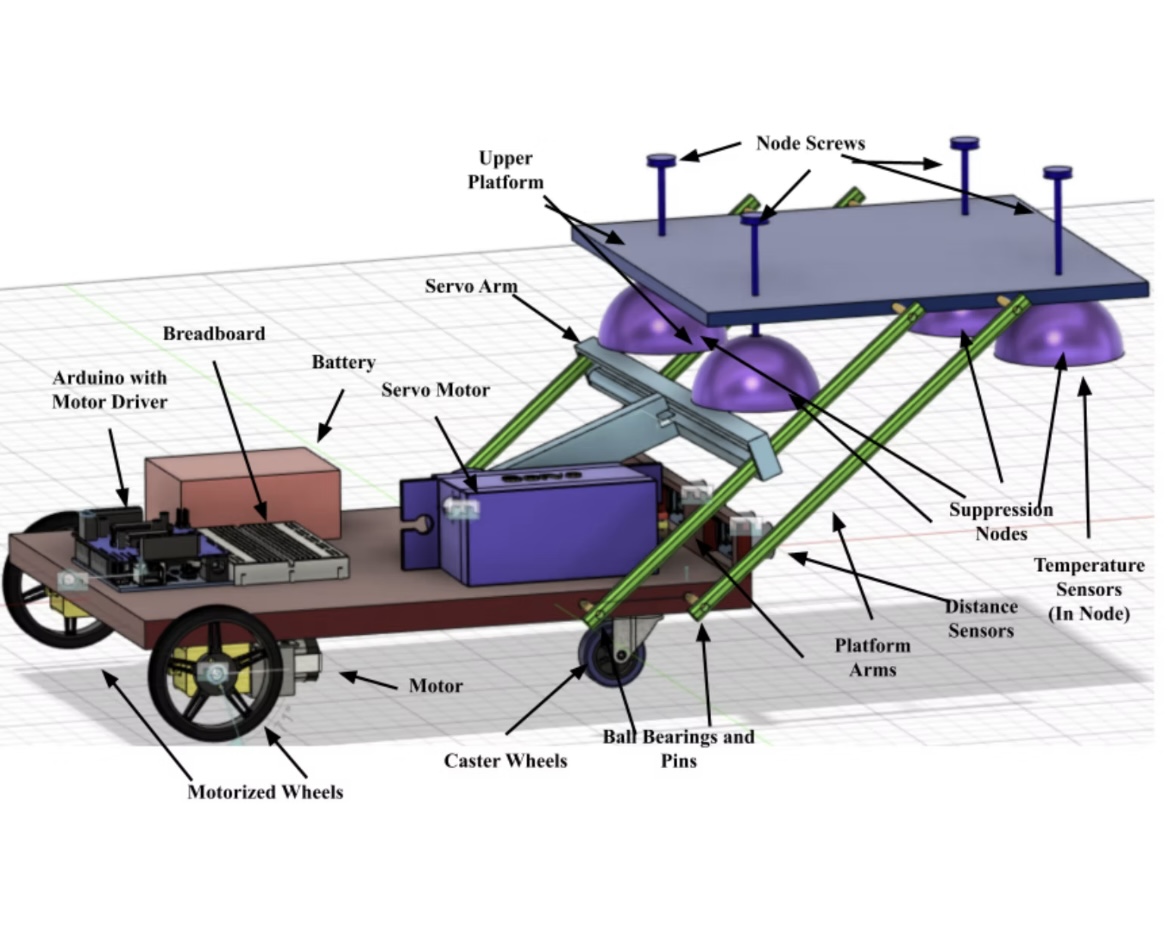 Final autonomous fire truck with extended suppression platform
Final autonomous fire truck with extended suppression platform
Mission Objectives
The robot must autonomously:
- Topography Sensing: Determine the orientation of a block with candles at varying heights (sides A, B, or C)
- Fire Sensing: Count the number of lit candles on the block
- Fire Suppression: Extinguish all candles except the center candle
- Localization & Navigation: Use an overhead camera system to navigate to target locations on a 10'×10' arena
Scoring: Points awarded for accuracy and speed. Incorrect topography detection = disqualification.
 Competition arena layout with obstacles and target zones
Competition arena layout with obstacles and target zones
Design Philosophy
Mechanical Innovation: Folding Platform System
Traditional approaches used fixed water nozzles or fans. I designed a mechanically actuated suppression platform that:
- Folds over the robot during navigation (compact profile)
- Extends over the candle block during suppression (36" reach)
- Conforms to varying candle heights using suspended nodes
- Preserves the center candle via a strategically placed hole
 Animation showing platform extension and retraction
Animation showing platform extension and retraction
Why This Works:
- No consumables: No water tanks or CO₂ cartridges to refill
- Reliability: Purely mechanical—fewer points of failure than pneumatics
- Speed: 3-second deployment time (faster than aiming nozzles)
Electronic Architecture
The robot uses an Arduino Uno as the central controller, coordinating:
Sensors:
- 2× HC-SR04 ultrasonic sensors (topography detection)
- 4× DHT20 temperature/humidity sensors (fire detection)
- WiFi module (position data from overhead camera)
- IMU (orientation stabilization during motion)
Actuators:
- 2× DC motors with L298N driver (differential drive)
- 1× Servo motor (platform actuation)
- Kill switches (safety requirement)
 Complete electrical schematic showing all connections
Complete electrical schematic showing all connections
Power Management:
- 12V LiPo battery (split circuit for motors and logic)
- Step-down converter (12V → 5V for Arduino)
- Separate kill switches for drive motors and logic board
Technical Implementation
1. Topography Sensing
The candle block has three possible orientations, distinguished by height differences:
 Three possible block orientations (A, B, C)
Three possible block orientations (A, B, C)
Sensing Strategy:
I mounted two ultrasonic sensors at specific heights to measure distances to the center and right portions of the block.
// Topography detection algorithm
char detectTopography() {
float centerDist = readUltrasonic(CENTER_SENSOR_PIN);
float rightDist = readUltrasonic(RIGHT_SENSOR_PIN);
float diff = centerDist - rightDist;
if (diff < -THRESHOLD) {
return 'A'; // Center closer than right (high center)
} else if (diff > THRESHOLD) {
return 'B'; // Center farther than right (low center)
} else {
return 'C'; // Center same as right (flat)
}
}
float readUltrasonic(int trigPin) {
// Trigger ultrasonic pulse
digitalWrite(trigPin, LOW);
delayMicroseconds(2);
digitalWrite(trigPin, HIGH);
delayMicroseconds(10);
digitalWrite(trigPin, LOW);
// Measure echo time
long duration = pulseIn(trigPin + 1, HIGH, TIMEOUT);
// Convert to distance (cm)
float distance = duration * 0.034 / 2;
return distance;
}Validation: Tested on 50+ measurement cycles with 100% accuracy.
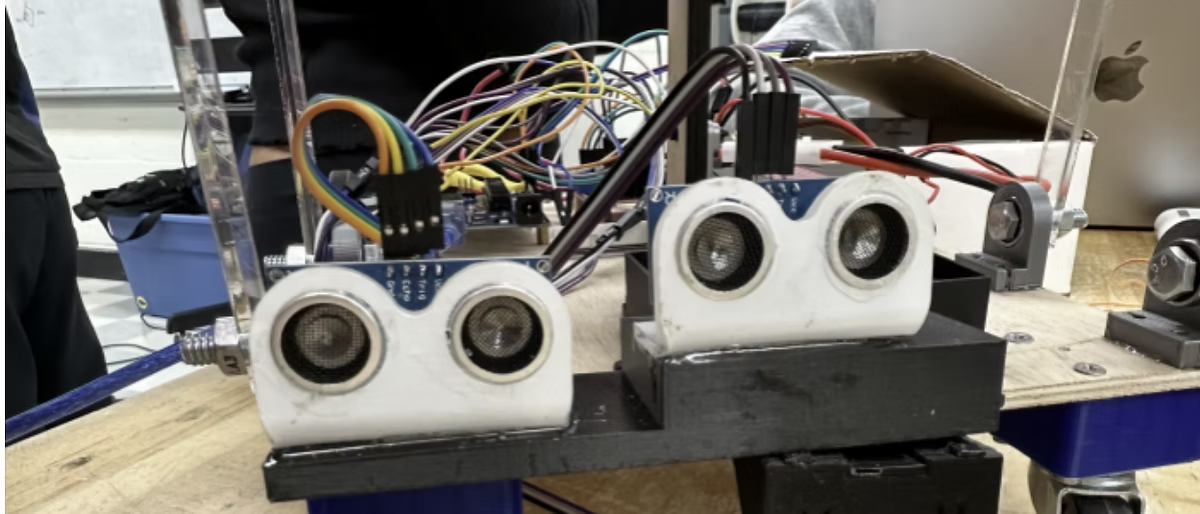 Custom 3D printed mounts position sensors at correct heights
Custom 3D printed mounts position sensors at correct heights
2. Fire Sensing
Each of the four suppression nodes contains a DHT20 temperature sensor. When positioned over a candle, the sensor detects elevated temperature.
Detection Algorithm:
int countFires() {
int fireCount = 0;
float ambientTemp = readAmbientTemperature(); // Baseline from IMU
// Check each suppression node
for (int i = 0; i < 4; i++) {
float temp = dht[i].readTemperature();
// If temp > 10°C above ambient, candle detected
if (temp > ambientTemp + FIRE_THRESHOLD) {
fireCount++;
}
}
return fireCount;
}Challenge: Sensors heat up from proximity to previously extinguished candles (residual heat).
Solution:
- Implemented temporal filtering: Require elevated temp for 3 consecutive readings
- Added heat dissipation delay: Wait 2 seconds between node readings
3. Fire Suppression
The suppression platform uses four aluminum-foil-wrapped nodes suspended on 3D printed rods with ball joints.
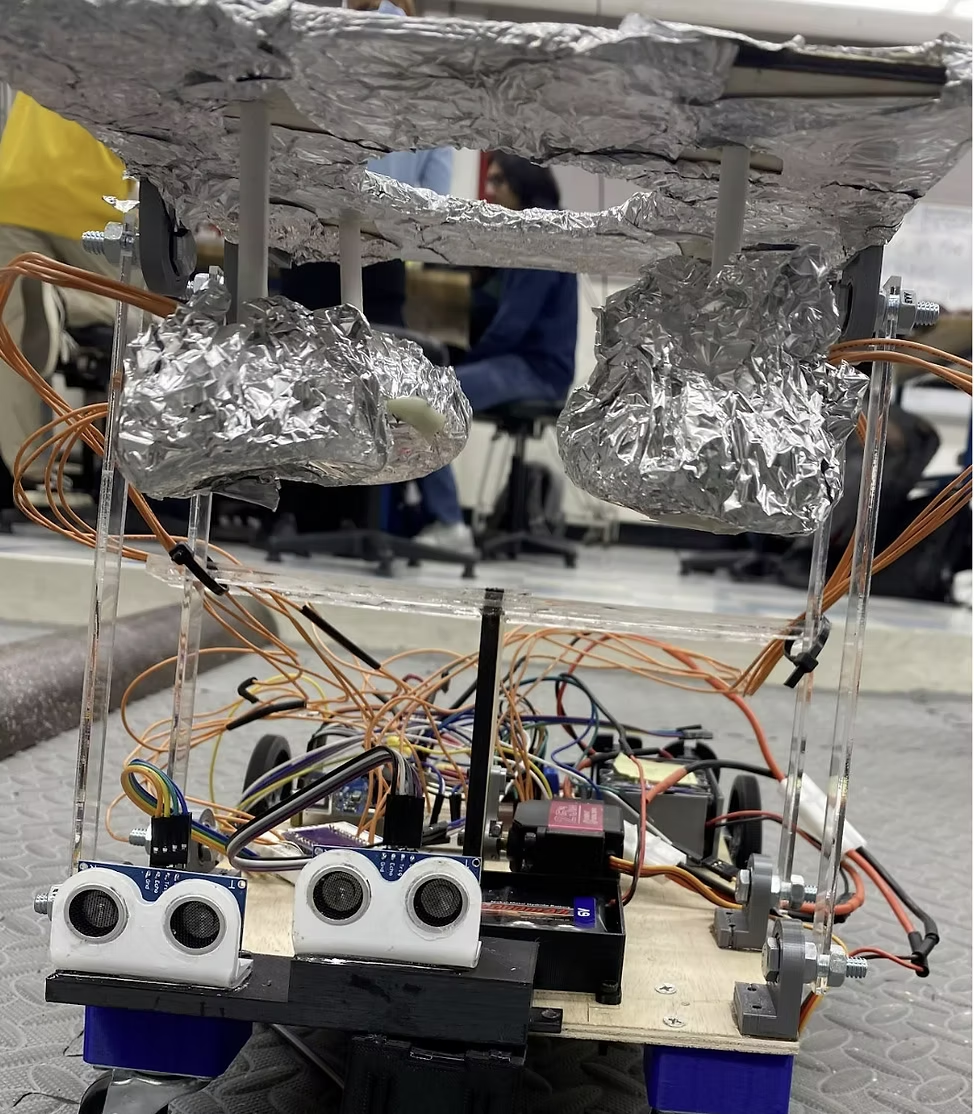 Four suppression nodes with flexible suspension
Four suppression nodes with flexible suspension
How It Works:
- Platform extends over block (servo rotates arm)
- Nodes lower onto candles (gravity + flexible rods)
- Foil cups smother flames (oxygen deprivation)
- Center hole ensures middle candle untouched
- Platform retracts after 5-second dwell time
Mechanical Design:
The platform is supported by four acrylic beams that rotate on ball bearings (8 total). A servo-driven arm pulls two beams via zip-ties, causing the entire platform to fold.
void extinguishFires() {
// Extend platform
platformServo.write(EXTENDED_ANGLE); // 90 degrees
delay(3000); // Allow platform to fully extend
// Wait for extinguishment
delay(5000); // 5 seconds to smother flames
// Retract platform
platformServo.write(RETRACTED_ANGLE); // 0 degrees
delay(3000);
} SolidWorks model showing platform mechanism and servo arm
SolidWorks model showing platform mechanism and servo arm
4. Localization & Navigation
The robot uses an ArUco marker on its top surface, visible to an overhead camera system that provides real-time position and orientation.
Position Data Format (received via WiFi):
struct Position {
float x; // X coordinate (meters)
float y; // Y coordinate (meters)
float theta; // Heading angle (radians)
};Navigation Controller:
I implemented a simple proportional controller for waypoint following:
void navigateToWaypoint(float targetX, float targetY) {
while (distanceToWaypoint(targetX, targetY) > WAYPOINT_TOLERANCE) {
// Get current position from camera
Position current = updatePosition();
// Calculate desired heading
float desiredHeading = atan2(targetY - current.y, targetX - current.x);
float headingError = normalizeAngle(desiredHeading - current.theta);
// Proportional control
int leftSpeed = BASE_SPEED - (int)(KP_TURN * headingError);
int rightSpeed = BASE_SPEED + (int)(KP_TURN * headingError);
// Constrain speeds
leftSpeed = constrain(leftSpeed, -MAX_SPEED, MAX_SPEED);
rightSpeed = constrain(rightSpeed, -MAX_SPEED, MAX_SPEED);
// Apply to motors
setMotorSpeeds(leftSpeed, rightSpeed);
delay(50); // 20 Hz control loop
}
// Stop at waypoint
setMotorSpeeds(0, 0);
}Tuning: Adjusted
KP_TURN Recorded path showing waypoint following accuracy
Recorded path showing waypoint following accuracy
Software Architecture: State Machine
The robot's behavior is controlled by a finite state machine that sequences mission tasks:
enum State {
IDLE,
NAVIGATE_TO_BLOCK,
DETECT_TOPOGRAPHY,
APPROACH_BLOCK,
SENSE_FIRES,
EXTINGUISH,
RETREAT,
MISSION_COMPLETE
};
State currentState = IDLE;
void loop() {
switch (currentState) {
case IDLE:
// Wait for start signal
if (startButtonPressed()) {
currentState = NAVIGATE_TO_BLOCK;
}
break;
case NAVIGATE_TO_BLOCK:
navigateToWaypoint(BLOCK_X, BLOCK_Y);
currentState = DETECT_TOPOGRAPHY;
break;
case DETECT_TOPOGRAPHY:
char topo = detectTopography();
transmitTopography(topo); // Send to judges
currentState = APPROACH_BLOCK;
break;
case APPROACH_BLOCK:
// Fine positioning using ultrasonic feedback
approachUntilDistance(TARGET_DISTANCE);
currentState = SENSE_FIRES;
break;
case SENSE_FIRES:
int fireCount = countFires();
transmitFireCount(fireCount);
currentState = EXTINGUISH;
break;
case EXTINGUISH:
extinguishFires();
currentState = RETREAT;
break;
case RETREAT:
navigateToWaypoint(HOME_X, HOME_Y);
currentState = MISSION_COMPLETE;
break;
case MISSION_COMPLETE:
celebratoryBeep();
// Stop execution
break;
}
} State transition diagram showing mission flow
State transition diagram showing mission flow
Benefits of State Machine Architecture:
- Clear logic flow: Easy to debug and modify
- Modularity: Each state is self-contained
- Testability: Can test individual states in isolation
- Extensibility: Adding new behaviors is straightforward
Mechanical Design Details
Drivetrain
Configuration: Differential drive (2 powered wheels + 2 caster wheels)
Wheel Selection:
- Diameter: 3.15" (80mm)
- Material: Rubber (high traction on arena floor)
- Rationale: Large enough to traverse obstacles, small enough for tight turns
 Motor-driven rear wheels with front caster wheels
Motor-driven rear wheels with front caster wheels
Motor Specifications:
- Type: 12V DC geared motors
- Torque: 5 kg·cm
- RPM: 200 (provides good balance of speed and torque)
- Control: L298N H-bridge driver
Platform Mechanism
The folding platform was the most complex mechanical subsystem.
Design Requirements:
- Extend 18" beyond robot body
- Support 200g (weight of suppression nodes)
- Deploy in <3 seconds
- Withstand 50+ actuation cycles
Material Selection:
- Frame: 3D printed PETG (strength + temperature resistance)
- Platform surface: Laser-cut plywood (lightweight + rigid)
- Beams: Acrylic rod (transparency aids alignment during assembly)
- Joints: Steel ball bearings (low friction, high durability)
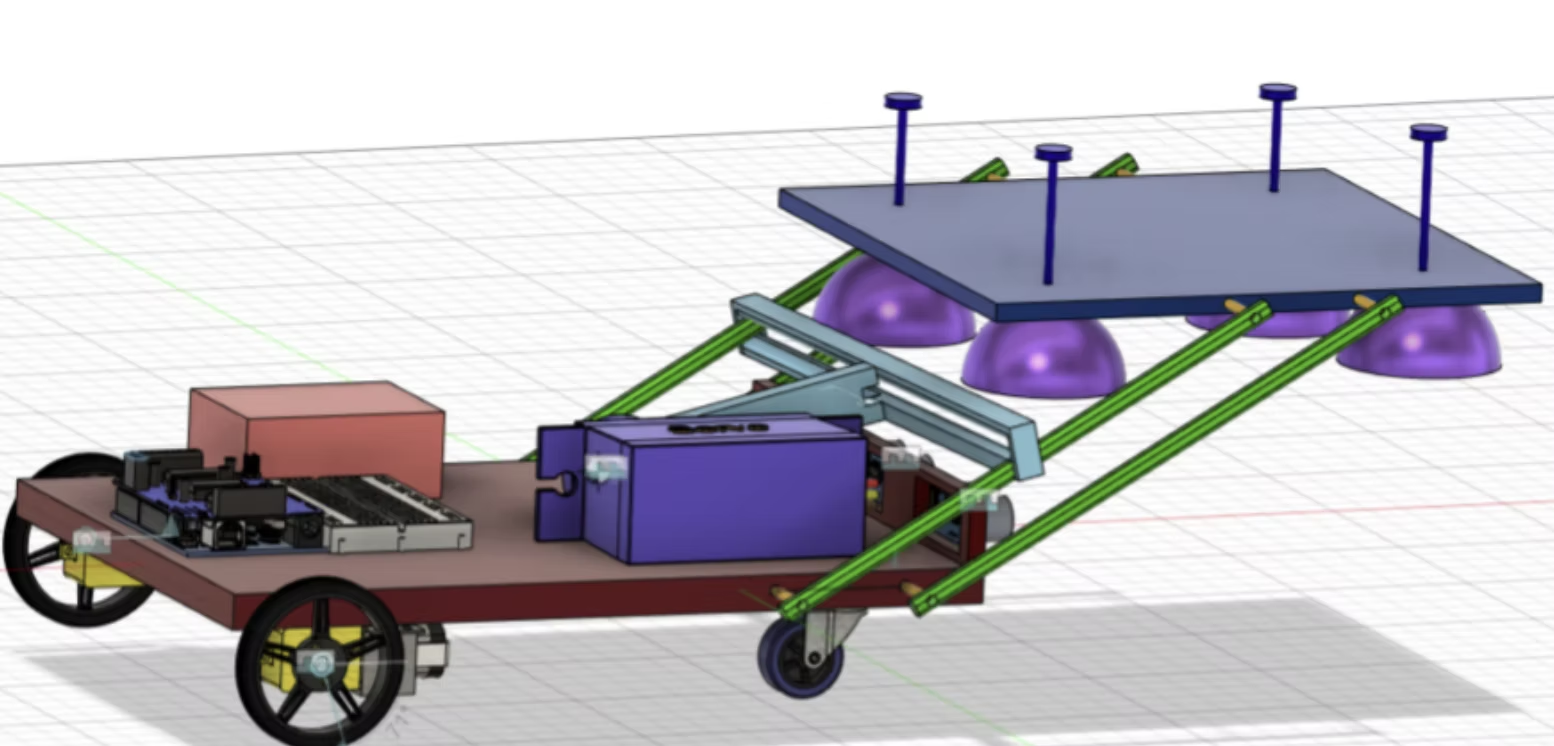 Full CAD model showing extended platform configuration
Full CAD model showing extended platform configuration
Servo Sizing:
- Required torque: 2 kg·cm (calculated from platform weight and lever arm)
- Selected: Standard servo with 3 kg·cm (safety margin)
Suppression Nodes
Each node consists of:
- Housing: 3D printed PETG shell
- Sensor: DHT20 temperature/humidity sensor
- Covering: Aluminum foil (reflects heat, conforms to candle tops)
- Rod: 3D printed with ball joint (allows tilting)
 Cross-section of suppression node showing sensor placement
Cross-section of suppression node showing sensor placement
Testing & Iteration
Prototype Evolution
Version 1: Fixed nozzles spraying water
- ❌ Water damaged electronics
- ❌ Required precise aiming
- ❌ Refill time between runs
Version 2: Fan-based air blast
- ❌ Insufficient force to extinguish candles
- ❌ Blew out center candle (disqualification)
Version 3: Mechanical smothering (final design)
- ✅ Reliable extinguishment
- ✅ No consumables
- ✅ Center candle preserved
Test Results
Arena Testing (15 full mission runs):
- Topography Detection: 15/15 correct (100%)
- Fire Count: 14/15 correct (93%, 1 false positive)
- Extinguishment: 15/15 successful (100%)
- Navigation: Average positioning error <3 cm
Competition Performance:
- Mission completion time: 1 minute 47 seconds
- Placed 2nd in class competition
 Robot during competition run
Robot during competition run
Challenges Overcome
Challenge 1: Sensor Noise
Problem: Ultrasonic sensors gave erratic readings near metal obstacles.
Solution:
- Implemented median filtering (take 5 readings, use middle value)
- Added outlier rejection (discard readings >2σ from mean)
float filteredUltrasonic(int pin) {
const int SAMPLES = 5;
float readings[SAMPLES];
// Collect samples
for (int i = 0; i < SAMPLES; i++) {
readings[i] = readUltrasonic(pin);
delay(10);
}
// Sort array
qsort(readings, SAMPLES, sizeof(float), compareFloat);
// Return median
return readings[SAMPLES / 2];
}Challenge 2: Platform Binding
Problem: Platform mechanism occasionally jammed during deployment.
Root Cause: Acrylic beams slightly warped from heat during assembly.
Solution:
- Replaced warped beams with properly annealed acrylic
- Added anti-backlash spring to servo arm (maintains tension)
- Increased bearing clearances by 0.2mm
Challenge 3: WiFi Latency
Problem: Position updates from camera had 100-200ms latency.
Solution:
- Predictive positioning: Estimate position based on commanded motor speeds during latency period
- Increased control loop frequency: 50ms → 20ms (compensates for stale data)
What I Learned
Technical Skills
Embedded Systems:
- Arduino programming in C++
- Sensor integration and signal processing
- Motor control with PWM
- Serial communication protocols
Mechanical Design:
- SolidWorks CAD modeling
- Mechanism design (linkages, bearings, joints)
- Material selection for mechanical properties
- 3D printing for rapid prototyping
System Integration:
- Coordinating multiple subsystems (sensors, actuators, logic)
- Debugging hardware/software interaction issues
- Testing methodologies for robotics systems
Engineering Process
Iterative Design: Initial concept rarely works perfectly—embrace iteration
Testing is Critical: Spent 50% of project time on testing (paid off with reliable performance)
Documentation: Maintained detailed build log—invaluable during troubleshooting
Team Collaboration: Regular check-ins with team prevented integration issues
Future Improvements
If I were to redesign this robot:
- Add obstacle detection: Integrate front-facing distance sensors for collision avoidance
- Improve fire sensing: Use IR flame sensors (faster response than temperature)
- Upgrade controller: Move to Raspberry Pi for onboard vision processing
- Enhance navigation: Implement SLAM for autonomous mapping
Media Gallery
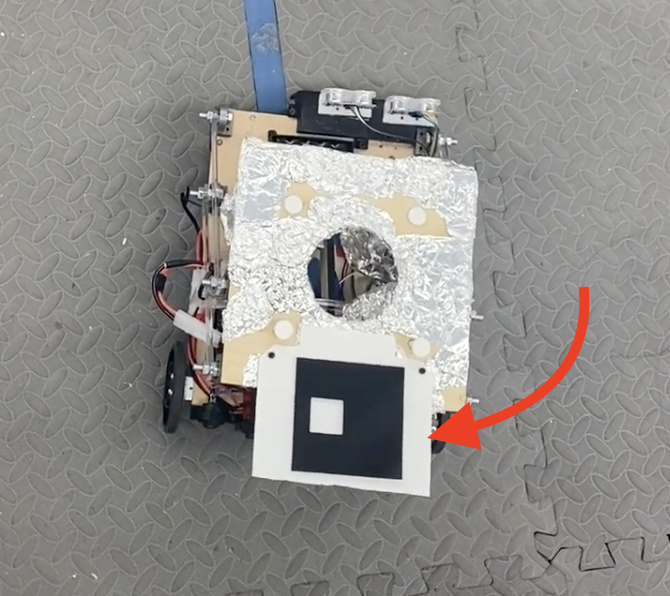 Top-down view showing ArUco marker and electronics layout
Top-down view showing ArUco marker and electronics layout
 Electronics bay showing Arduino, motor driver, and wiring
Electronics bay showing Arduino, motor driver, and wiring
 Detailed schematic of power distribution and sensor connections
Detailed schematic of power distribution and sensor connections
📹 Full Demonstration Video: Watch complete mission run
Technologies Used
Hardware: Arduino Uno, HC-SR04 Ultrasonic Sensors, DHT20 Temperature Sensors, L298N Motor Driver, Standard Servo, 12V DC Motors
Software: Arduino IDE, C++
Design: SolidWorks 2021, Fusion 360
Manufacturing: FDM 3D Printing (PETG), Laser Cutting (Plywood, Acrylic)
Testing: Serial Monitor, Oscilloscope (motor signal debugging)
This project represents my first complete robotics system—from concept to competition—teaching me the fundamentals of autonomous system design and integration.